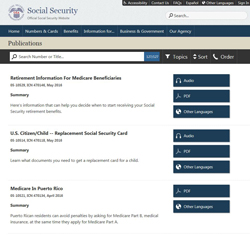Social Security Disability Helps People Who Work

People with disabilities are challenged with both overcoming barriers and with convincing others that those barriers do not define them. Social Security provides an economic lifeline to America’s workers through our benefit programs. We run the largest disability program in the nation. In Washington state, over 180,000 people receive Social Security disability monthly payments. In addition, there are over 33,000 children and spouses who receive disability insurance benefits. That is more than $2.7 billion per year.
The Social Security disability insurance program (SSDI) is perhaps the most misunderstood program of Social Security. Some people may think that SSDI recipients have never worked and are taking advantage of the system by receiving money for minor impairments.
Nothing could be further from the truth. First, anyone who qualifies for SSDI must have worked enough to pay into the system and be “insured.” Second, Social Security has some of the strictest requirements in the world for disability benefits. To qualify, a person must not only have an impairment that will last one year or more, or result in death, but they must be unable to perform any substantial work.
Consequently, Social Security disability beneficiaries are some of the most severely impaired people in the country, and they greatly depend on their benefits. You can learn more by visiting the Social Security Faces and Facts webpage. You will find many personal stories of those who have benefitted from Social Security when they needed it most.
Fifty-six million Americans (one in five) live with disabilities. Thirty-eight million disabled Americans (one in 10) live with severe disabilities. Disability is something many Americans, especially younger people, think can only affect the lives of other people.
Many serious medical conditions, such as cancer or mental illness, affect the young as well as the elderly. The sobering fact for 20-year-olds, insured for disability benefits, is that more than one in four of them becomes disabled before reaching retirement age. As a result, they may need to rely on the Social Security disability benefits for income support. Our disability benefits provide a critical source of financial support to people when they need it most.
We also have incentives that give beneficiaries with disabilities—who are able—the opportunity to return to work. These work incentives include continued cash benefits for a period of time while you work, continued Medicare or Medicaid coverage, and help with education, training, and rehabilitation to start a new line of work. In some cases, we may even be able to deduct certain impairment-related work expenses from your countable income, making it possible to earn more and also remain eligible to receive benefits. Examples of these expenses are wheelchairs, transportation costs, and specialized equipment needed for work.
For more information about work incentives, visit the Social Security Ticket to Work webpage or call 1-866-968-7842 (TDD 866-833-2967).
Contributor Kirk Larson is a public affairs specialist at Social Security Washington.
Listen and Learn About Social Security
Did you know that the Social Security offers free audio publications?
 Social Security wants to make sure you can get the information you need. That’s why they offer more than a hundred publications in audio format, in both English and Spanish. You can find them at www.ssa.gov/pubs/audio/audio.html and, with additional formats, at www.ssa.gov/pubs.
Social Security wants to make sure you can get the information you need. That’s why they offer more than a hundred publications in audio format, in both English and Spanish. You can find them at www.ssa.gov/pubs/audio/audio.html and, with additional formats, at www.ssa.gov/pubs.
Social Security is committed to using technology to improve the customer service experience. In addition to print, publications are available online in both Internet and PDF versions, and can be requested in Braille, enlarged print, or on cassette or CD.
If you are blind or visually impaired and are having trouble reading a Social Security notice you receive in the mail, you can ask a Social Security representative to read it and explain it to you. You can contact Social Security as many times as you want to get an explanation. Call 800-772-1213 for assistance.
![AgeWise King County [logo]](https://www.agewisekingcounty.org/wp-content/themes/agewisekingcounty/images/logo.png)